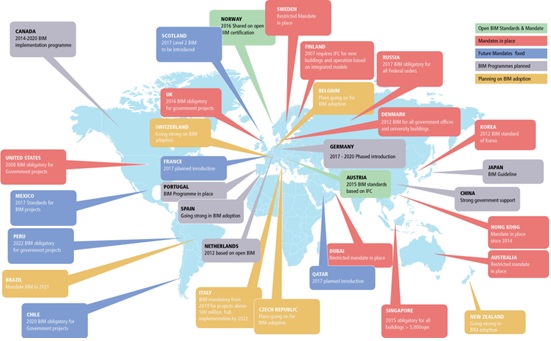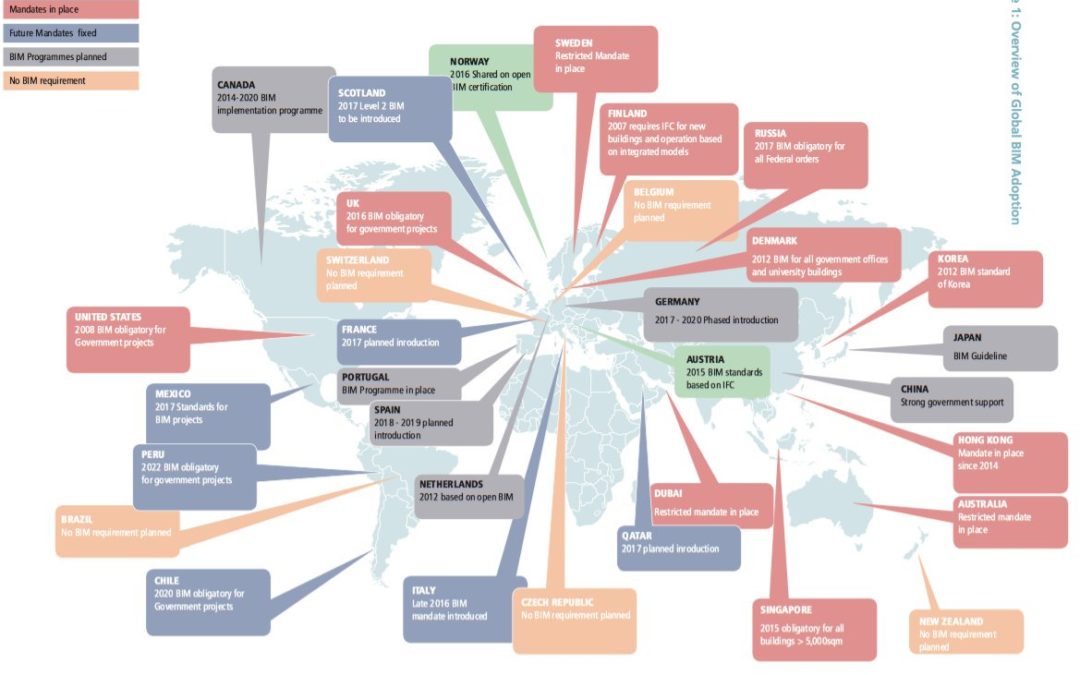Well, to this question I imagine that many already intuit the answer, but let’s reflect a little and maybe we could take it to debate.
Building Information Modeling (BIM) currently represents that great blue knight who comes to save the construction industry. Already in many countries of the world that have adopted BIM as a way of working and are having the expected results. Many young students and professionals of the construction sector of the Dominican Republic, seeing this new trend, this great technological gentleman, wonder if it is reasonable to make a career in the BIM methodology at the moment.
Well here a little perspective before answering that question;
Currently the use of the BIM methodology in Engineering, architecture and construction is present in all the continents of the world and today it is being mandatory in government projects in countries such as; United Kingdom, Switzerland, Denmark, Italy, Finland, Spain and Russia. In the United States since 2006, General Services Administration (GSA) published a mandate that BIM should be used in the design phase in all new construction projects. It is not yet mandatory at the national level but many states independently require it for public projects according to their own standards.
The Government of Germany in 2015 created the “Digital Buildings Platform”, a diverse group of the construction industry to develop a “National BIM strategy”. The government’s plan is to make the use of BIM mandatory in all public infrastructure projects.
United Arab Emirates makes incentives to apply BIM in projects with specific characteristics.
In South Korea, public projects that exceed a budget of 50 million dollars cannot be tendered if you do not submit your proposal to BIM.
Chile requires that for hospital projects they are presented in BIM methodology.
Singapore, as always, take things radically, they created “the Building and Construction Authority (BCA)” that seeks to promote the use of BIM in the entire country. For this they established the digital sending of the projects, forcing the engineers and architects to present their proposals through BIM.
Many more countries are already implementing the BIM methodology at different levels and are also seeking initial implementation from the public sector, it is presumed that for the coming years France and Australia would make the use of this methodology mandatory in their public projects, others such as Brazil, New Zealand, Japan and China would be encouraging its use more intensely.

The map above collects from the research of the Dublin Institute of Technology 2007, It shows in green and red the countries where BIM use is mandatory, in blue the countries where it is already agreed that it will be mandatory in the near future, in purple those that already they have an elaborate plan and strategy and in orange those who have a plan to adopt BIM.
Then the question arises, BIM in the Dominican Republic for when?
BIM in the country is currently in diapers, although many of the professionals in the sector are aware that it exists and say they know its benefits, the truth is that the greatest barrier for BIM to impose itself is precisely the lack of trained professionals in said methodology and tools.
BIM is already here and you can start to take advantage of its technology, but we can really say that BIM has started to walk when our government assumes public incentive policies for its application.
“One of the points that is clear is that the countries with the highest level of BIM implementation already have or are working on national mandates for the regulation of BIM information exchanges. Although these mandates do not immediately determine the success of the implementation strategy, they definitely drive the methodology positively. When BIM has a mandatory governmental character, the demand for BIM models is no longer solely at the discretion of the client. This ensures a more organized growth of industry dividends ”Erick J. Vásquez Guerra
Currently, a few private companies use BIM, say that at medium levels, there are also various initiatives such as ProBIM.org that seek to promote the methodology and publicize its benefits. Today we have many challenges that range from overcoming the learning and change of mind curve to achieving public policies that unite us as a nation in a better way of managing projects.
Any predictions?

- No one who finds out that there are cars will try to learn to ride a horse.
- All CAD users will have to move to BIM
- It will be very necessary to hire technicians or professionals who know how to model BIM projects, someone to prepare reports and reports from the BIM model, someone to quantify and review the models.
- Many architects will become BIM specialists and consultants to guide other firms to jump from traditional methods to BIM.
- It will be very necessary that professionals with experience in design and construction become “BIM Managers” to support in the pursuit of goals, compliance with BIM standards.
- The government will need professionals for the management and processing of models and the incorporation and application of standards.
- A lot of demand and little supply of professional experts in BIM methods and tools.
- The use of BIM will allow establishing a standard of project development, a significant improvement in productivity and once the learning curve has been overcome; higher performance or shorter deadlines in the development of usual tasks in the projects or cover more projects by the same number of professionals.
- Foreign capital investments will require the design and management of your projects using the BIM methodology.
All this is happening today August 2019, what do you think ?, how soon will we see projects fully prepared in BIM to be tendered? Tell us what you think.


Hello, First of all, I read your article and your information about bim is very amazing and so much helpful for me. Keep it up and Thank you very much.:)